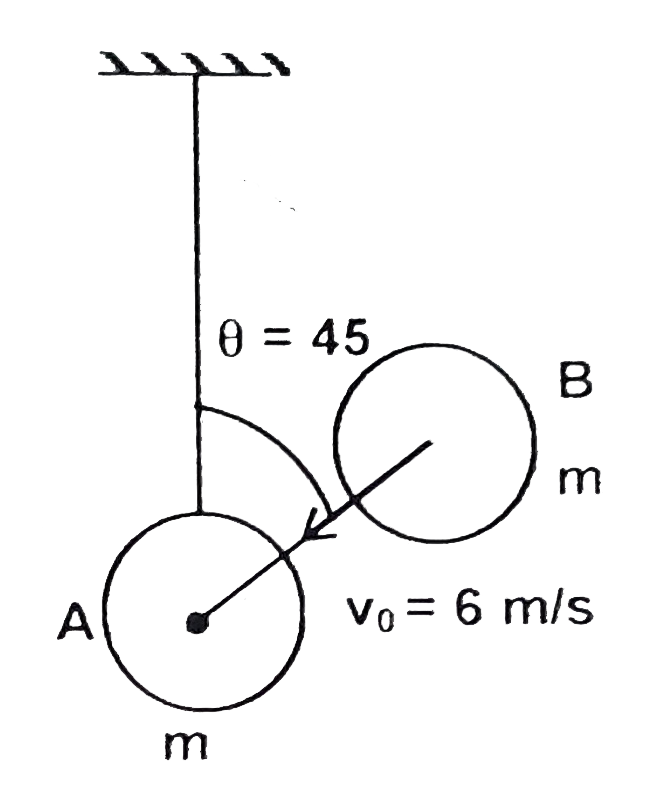A body of mass M is attached to the lower end of a metal wire, whose upper end is fixed . The elongation of the wire is l.
Loss in gravitational potential energy of M is Mgl
Elastic potential energy stored in the wire is Mgl2
Elastic potential energy stored in the wire is Mgl
Elastic potential energy stored in the wire is Mgl3
The correct Answer is:A, B
Loss in gravitational potential energy of M is Mgl as M falls down by l.
Elastic potential energy stored in wire is
U=12×Stress×Strain×Volume
=1212×MgA×lL×AL=Mgl2
Now work done by gravityy force is not equal to elastic potential energy stored in wire. This is due to the fact that some work has been done against air friction etc., which increases the internal energy of wire.
Topper's Solved these Questions
- PROPERTIES OF SOLIDS AND FLUIDSBook:CENGAGE PHYSICSChapter:PROPERTIES OF SOLIDS AND FLUIDSExercise:Assertion- Reasoning
Explore 13 Videos
- PROPERTIES OF SOLIDS AND FLUIDSBook:CENGAGE PHYSICSChapter:PROPERTIES OF SOLIDS AND FLUIDSExercise:Linked Comprehension
Explore 30 Videos
- PROPERTIES OF SOLIDS AND FLUIDSBook:CENGAGE PHYSICSChapter:PROPERTIES OF SOLIDS AND FLUIDSExercise:Single Correct
Explore 112 Videos
- NEWTON'S LAWS OF MOTION 2Book:CENGAGE PHYSICSChapter:NEWTON'S LAWS OF MOTION 2Exercise:Integer type
Explore 1 Video
- RIGID BODY DYNAMICS 1Book:CENGAGE PHYSICSChapter:RIGID BODY DYNAMICS 1Exercise:Integer
Explore 11 Videos
Similar Questions
By how much will a 3.0 m long copper wire elongate if a weight of 10 kg is suspended from the lower end with the upper end keeping fixed? The diameter of the wire is 0.4 mm. Given: Y for copper =1011Nm−2 and g=9.8ms−2
View SolutionA metal wire of length L is suspended vertically from a rigid support. When a bob of mass M is attached to the lower end of wire, the elongation of the wire is l:
View Solution
Knowledge Check
A body of mass M is attached to lower end of a metal wire whose upper and is fixed. The elongation is l. The ratio of loss of gravitational potential energy to the energy stored in the wire is
A1B2C12D43A body of mass m is attached to the lower end of a spring whose upper end is fixed. The spring has negligible mass. When the mass m is slightly pulled down and released, it oscillates with a time period of 3s. When the mass m is increased by 1kg, the time period of oscillations becomes 5s. The value of m in kg is
A34B43C169D916A ball of mass m is attached to the lower end of a vertical string whose upper end is fixed. An identcial ball 'B' moving with a velocity v0=6m/s at an angle θ=45∘ from vertical collides elastically with the ball 'A' as shown.
The verocity of the ball 'B' just after collision is
 A5m/sB4m/sC3m/sD2m/s
A5m/sB4m/sC3m/sD2m/s
A block of mass M is attached to the lower end of a vertical rope of mass m. An upward force P acts on the upper end of the rope. The system is free to move. The force exerted by the rope on the block is PMM+m
View SolutionA steel wire of negligible mass length L0 and cross sectional area A0 is kept on a smooth horizontal table with one end fixed. A ball of mass M is attached to the other end. The wire and ball are rotating with angular velocity ω . If elongation in the wire is ΔL, then the value of Young's modulus of elasticity will be
View SolutionA metal wire of length L1 and area of cross-section A is attached to a rigid support. Another metal wire of length L2 and of the same cross-sectional area is attached to free end of the first wire. A body of mass M is then suspended from the free end of the second wire. If Y1andY2 are the Young's moduli of the wires respectively, the effective force constant of the system of two wire is
View SolutionA metal wire of length L1 and area of cross section A is ttached to a rigid support. Another metal wire of length L2 and of the same cross sectional area is attached to the free end of the first wire. A body of mass M is then suspended from the free end of the second wire, if Y1 and Y2 are the Young's moduli of the wires respectively the effective force constant of the system of two wires is
View SolutionA metal wire of negligible mass, length 1 m and cross-sectional area 10−6m2 is kept on a smooth horizontal table with one end fixed on the table. A ball of mass 2kg is attached to the other end of the wire. When the wire and the ball are rotated with angular velocity of 20 rad/s, it is found that the wire is elongated by 10−3m. If the Young's modulus of the metal is n×1011N/m2, then the value of n is
View Solution

